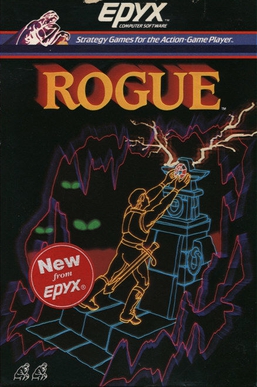In computing, a Trojan horse is any malware that misleads users of its true intent by disguising itself as a standard program. The term is derived from the ancient Greek story of the deceptive Trojan Horse that led to the fall of the city of Troy.

Phrack is an e-zine written by and for hackers, first published November 17, 1985. It had a wide circulation which included both hackers and computer security professionals.

Karl Werner Lothar Koch was a German hacker in the 1980s, who called himself "hagbard", after Hagbard Celine. He was involved in a Cold War computer espionage incident.
A filename extension, file name extension or file extension is a suffix to the name of a computer file. The extension indicates a characteristic of the file contents or its intended use. A filename extension is typically delimited from the rest of the filename with a period, but in some systems it is separated with spaces.

Rogue is a dungeon crawling video game by Michael Toy and Glenn Wichman with later contributions by Ken Arnold. Rogue was originally developed around 1980 for Unix-based minicomputer systems as a freely distributed executable. It was later included in the Berkeley Software Distribution 4.2 operating system (4.2BSD). Commercial ports of the game for a range of personal computers were made by Toy, Wichman, and Jon Lane under the company A.I. Design and financially supported by the Epyx software publishers. Additional ports to modern systems have been made since by other parties using the game's now-open source code.

This timeline of computer viruses and worms presents a chronological timeline of noteworthy computer viruses, computer worms, Trojan horses, similar malware, related research and events.
A rootkit is a collection of computer software, typically malicious, designed to enable access to a computer or an area of its software that is not otherwise allowed and often masks its existence or the existence of other software. The term rootkit is a compound of "root" and the word "kit". The term "rootkit" has negative connotations through its association with malware.

In software development, a README file contains information about the other files in a directory or archive of computer software. A form of documentation, it is usually a simple plain text file called README, Read Me, READ.ME, README.TXT, README.md, or README.1ST.

Unix System V is one of the first commercial versions of the Unix operating system. It was originally developed by AT&T and first released in 1983. Four major versions of System V were released, numbered 1, 2, 3, and 4. System V Release 4 (SVR4) was commercially the most successful version, being the result of an effort, marketed as Unix System Unification, which solicited the collaboration of the major Unix vendors. It was the source of several common commercial Unix features. System V is sometimes abbreviated to SysV.
A logic bomb is a piece of code intentionally inserted into a software system that will set off a malicious function when specified conditions are met. For example, a programmer may hide a piece of code that starts deleting files, should they ever be terminated from the company.
A security hacker is someone who explores methods for breaching defenses and exploiting weaknesses in a computer system or network. Hackers may be motivated by a multitude of reasons, such as profit, protest, information gathering, challenge, recreation, or evaluation of a system weaknesses to assist in formulating defenses against potential hackers.

Marshall Kirk McKusick is a computer scientist, known for his extensive work on BSD UNIX, from the 1980s to FreeBSD in the present day. He was president of the USENIX Association from 1990 to 1992 and again from 2002 to 2004, and still serves on the board. He is on the editorial board of ACM Queue Magazine. He is known to friends and colleagues as "Kirk".
In computer security, the Zardoz list, more formally known as the Security-Digest list, was a famous semi-private full disclosure mailing list run by Neil Gorsuch from 1989 through 1991. It identified weaknesses in systems and gave directions on where to find them. Zardoz is most notable for its status as a perennial target for computer hackers, who sought archives of the list for information on undisclosed software vulnerabilities.
The Jargon File is a glossary and usage dictionary of slang used by computer programmers. The original Jargon File was a collection of terms from technical cultures such as the MIT AI Lab, the Stanford AI Lab (SAIL) and others of the old ARPANET AI/LISP/PDP-10 communities, including Bolt, Beranek and Newman, Carnegie Mellon University, and Worcester Polytechnic Institute. It was published in paperback form in 1983 as The Hacker's Dictionary, revised in 1991 as The New Hacker's Dictionary.
Max Ray Vision is a former computer security consultant and hacker who served a 13-year prison sentence, the longest sentence ever given at the time for hacking charges in the United States. He was convicted of two counts of wire fraud, including stealing nearly 2 million credit card numbers and running up about $86 million in fraudulent charges.

Boris Loza is the founder of SafePatrol Solutions and Tego Systems, as well as a Certified Information Systems Security Professional (CISSP). He was born in Krasnodar, Russia, where he attained a Master's degree at the age of 22 and a PhD at the age of 26, both in Computer Science and Cybernetics. While still living in the former USSR, Loza published more than 30 scientific articles, as well as secured one patent. Upon relocating to Canada in 1996, his PhD was confirmed by the Higher Attestation Committee of The University of Toronto.
Jean-Bernard Condat is a French computer security expert and former hacker who became a consultant to the Directorate of Territorial Surveillance (DST). Using the name concombre, he achieved status as one of the best-known French hackers in the 1990s.
Visionware Ltd was a British software company that developed and marketed products that helped integration of Microsoft Windows clients to Unix-based server applications. It was based in Leeds in West Yorkshire. The three products it was most known for were PC-Connect, XVision, and SQL-Retriever.









